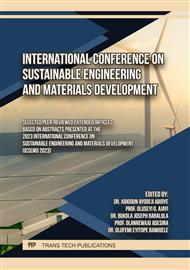[1]
Lamare, R.E., & Singh, O.P. (2020). Effect of cement dust on soil physico-chemical properties around cement plants in Jaintia Hills, Meghalaya. Environmental Engineering Research, 25(3), 409-417.
DOI: 10.4491/eer.2019.099
Google Scholar
[2]
Andrew, R. M. (2018). Global CO 2 emissions from cement production. Earth System Science Data, 10 (1), 195-217.
Google Scholar
[3]
Zargari F, Hekmatshoar H, Dilmaghani A, Eslam BP (2008), Chemical and physical properties of Soofian's cement dust and its effect on some aspects of growth in two cultivars of sunflower. J. Environ. Res. Dev.;3:20-29.
Google Scholar
[4]
Jain R, Jain PL. Pollution of soil due to cement factory near Narsingarh, Madhya Pradesh (India). J. Environ. Res. Dev. 2006;1:151-154.
Google Scholar
[5]
Ramesh, V., Ahmed John, S., & Koperuncholan, M. (2014). Impact Of Cement Industries Dust On Selective Green Plants: A Case Study In Ariyalur Industrial Zone. International Journal of Pharmaceutical, Chemical & Biological Sciences, 4(1).
Google Scholar
[6]
Masindi, V., & Muedi, K. L. (2018). Environmental contamination by heavy metals. Heavy metals, 10,115-132.
DOI: 10.5772/intechopen.76082
Google Scholar
[7]
Saxena, P., & Sonwani, S. (2019). Primary criteria air pollutants: environmental health effects. In Criteria air pollutants and their impact on environmental health (pp.49-82). Springer, Singapore.
DOI: 10.1007/978-981-13-9992-3_3
Google Scholar
[8]
Gheorghe, I. F., & Ion, B. (2011). The effects of air pollutants on vegetation and the role of vegetation in reducing atmospheric pollution. The impact of air pollution on health, economy, environment and agricultural sources, 29, 241-80.
DOI: 10.5772/17660
Google Scholar
[9]
Samdariya, N., Sharma, A., & Shukla, R. K (2021) Impact of Cement Plant on Rural Economy: A Review.
Google Scholar
[10]
Kolawole, G. O., Eniola, O., & Oyeyiola, Y. B. (2018). Effects of nutrients omission on maize growth and nutrient uptake in three dominant soil types of southwestern Nigeria. Journal of Plant nutrition, 41(15), 1903-1915.
DOI: 10.1080/01904167.2018.1482909
Google Scholar
[11]
Ade-Ademilua, O.E. and Obalola, DA. (2008).The Effect of Cement Dust Pollution on Celosia argentea (Lagos Spinach) Plant Journal of Environmental Science and Technology, 1: 47-55
DOI: 10.3923/jest.2008.47.55
Google Scholar
[12]
Adebiyi, A. P., Adigun, H. O., Lawal, K. J., Salami, K. D., Adekunle, V. A. L., & Oyelakin, J. A. (2021). Impact of cement dust on physical and chemical nutrients properties of forest topsoil. Journal of Applied Sciences and Environmental Management, 25(5), 695-700.
DOI: 10.4314/jasem.v25i5.2
Google Scholar
[13]
Saheed, k. o., Kubili, y., Sikiru, b. m., Chukwudi, c. e., & Mohammed, G. A. (2021). Growth Response of Hibiscus cannabinus to the effect of Cement, Bima Journal of Science and Technology (2536-6041), 5(02), 154-162.
Google Scholar
[14]
Ambler, S. O. (2020). A first assessment of nitrogen sources and biogeochemical processing in the speleothem record (Doctoral dissertation, Lancaster University (United Kingdom)).
Google Scholar
[15]
Öztürk, M., Ashraf, M., Aksoy, A., Ahmad, M. S. A., & Hakeem, K. R. (Eds.). (2015). Plants, pollutants and remediation. Berlin/Heidelberg, Germany: Springer.
DOI: 10.1007/978-94-017-7194-8
Google Scholar
[16]
Leng, R. A. (2017). Biofilm compartmentalization of the rumen microbiome: modification of fermentation and degradation of dietary toxins. Animal Production Science, 57(11), 2188-2203.
DOI: 10.1071/an17382
Google Scholar
[17]
Olurin, O. T., Badmus, B. S., Akinyemi, O. D., Olowofela, J. A., Ozebo, V. C., & Ganiyu, S. A. (2012). Analysis of physical parameters of limestone deposits in Ewekoro formation, Southwestern Nigeria, Earth Science Research, 1(2), 117.
DOI: 10.5539/esr.v1n2p117
Google Scholar
[18]
Gbadebo, A. M., Oyedepo, J. A., & Taiwo, A. M. (2010). Variability of nitrate in groundwater in some parts of Southwestern Nigeria, The Pacific Journal of Science and Technology, 11(2), 572-584.
Google Scholar
[19]
Wonodi, A., and Ekpete, O. A. (2021). Impact Of Cement Production Factories on the Physical and Chemical Characteristics of Soil Within Production Areas In Port Harcourt Metropolis, Rivers State, Niger Delta, Nigeria, Faculty of Natural and Applied Sciences Journal of Scientific Innovations, 3(1), 50-59
Google Scholar
[20]
International Center for Agricultural Research in the Dry Areas (ICARDA), 2001. Soil and Plant Analysis Laboratory Manual, ICARDA and NARC, Syria.
DOI: 10.18006/2017.5(spl-1-safsaw).s76.s85
Google Scholar
[21]
Bremner, J. M. Mulvaney. CS (1982). Total nitrogen. Methods of Soil Analysis. P Part, 2, 9595-624.
Google Scholar
[22]
Association of Official Analytical Chemists [AOAC]. (1990). Official Methods of Analysis.
Google Scholar
[23]
Bremner, J.M. 1996. Nitrogen-total. In Methods of soil analysis, Part 3, Chemical methods. (Ed. D.L. Sparks), pp.1085-1121. Nº 5. Soil Science Society of America Book Series. Soil Science Society of America, Inc. and American Society of Agronomy Inc., Madison, Wisconsin, USA.
DOI: 10.2136/sssabookser5.3.c37
Google Scholar
[24]
Singh, J.P. (1988). A rapid method for determination of nitrate in soil and plant extracts. Plant and soil, 110, 137-139.
DOI: 10.1007/bf02143549
Google Scholar
[25]
Silva, J. A. (1964). Determination of fixed ammonium in soils. Iowa State University.
Google Scholar



